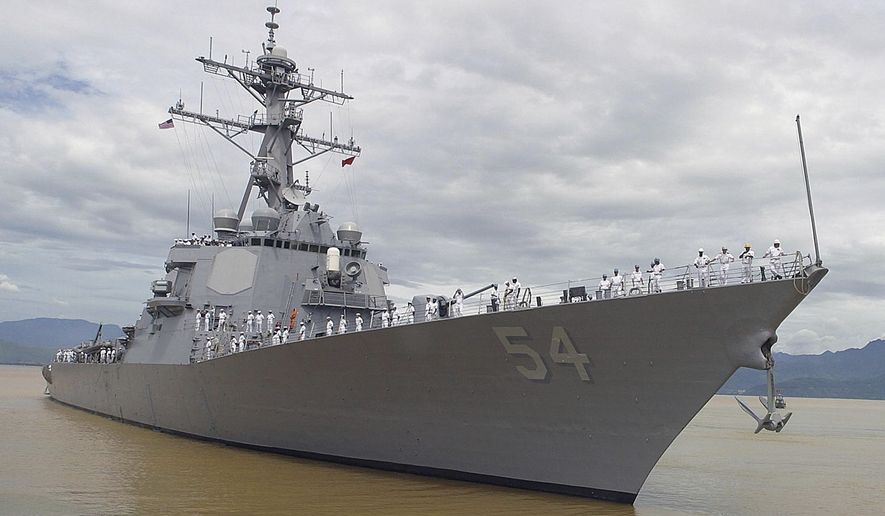A Navy guided-missile destroyer sailed near disputed islands in the South China Sea in a challenge to expansive Chinese claims to own most of the waterway, the Navy said Thursday.
The USS Curtis Wilbur conducted a freedom of navigation operation, or FONOP, near the Parcel Islands. U.S. Navy officials denied Chinese claims that the warship was forced to withdraw from the area by a PLA warship.
“The PLA’s statement about this mission is false,” the Navy’s Seventh Fleet said in a rare and lengthy public rebuttal of Chinese propaganda claims. The USS Curtis Wilbur “was not ‘expelled’ from any nation’s territory. USS Curtis Wilbur conducted this [operation] in accordance with international law and then continued on to conduct normal operations in international waters.”
The warship passage is part of stepped-up naval and air operations in the disputed South China Sea, 1.3 million square miles of international waters that China has claimed as being mostly its sovereign territory.
The State Department in 2020 declared most Chinese claims to the sea “completely unlawful” under international law, following a 2016 ruling by an international tribunal ruling that China has no historic claims to owning the sea.
“The United States will continue to fly, sail and operate wherever international law allows, as USS Curtis Wilbur did here,” the Navy said.
China’s military “strongly opposes” the Wilbur’s passage near the Paracels, which China calls the Xisha. The PLA’s Southern Command charged that the U.S. ship was trespassing.
PLA forces mobilized to track and warn the ship to leave the area, PLA Air Force Sen. Col. Tian Junli, a command spokesman, said, adding that the passage was “unprofessional and irresponsible.”
“The action by the U.S. has seriously violated China’s sovereignty and security, and severely undermined peace and stability in the region,” Col. Tian said. “It has violated international laws and basic principles in international relations, deliberately increased regional security risks, and can easily lead to misunderstanding, misjudgment and maritime accidents.”
Col. Tian said the United States has become a “security risks generator in the South China Sea.”
According to the U.S. Navy, the PLA statement on the action against the Wilbur “is the latest in a long string of [Chinese] actions to misrepresent lawful U.S. maritime operations and asserts its excessive and illegitimate maritime claims at the expense in the Southeast Asian neighbors in the South China Sea.”
The statement claimed that China’s behavior contrasts sharply with American adherence to international law and the U.S. vision for a free and open Indo-Pacific region.
“All nations, large and small, should be secure in their sovereignty, free from coercion, and able to pursue economic growth consistent with accepted international rules and norms.”
Rear Adm. Charlie Brown, chief of Navy information, said on Twitter: “Unlawful and sweeping maritime claims in the South China Sea pose a serious threat to the freedom of the seas, including the freedoms of navigation and overflight, free trade and unimpeded commerce, and freedom of economic opportunity for South China Sea littoral nations.”
The Navy said it will continue to conduct the operations as long as “some countries” continue to assert maritime claims that are inconsistent with international law under the 1982 Law of the Sea Convention.
“The United States will continue to defend those rights and freedoms,” the statement said. “No member of the international community should be intimidated or coerced into giving up their rights and freedoms.”
China, Taiwan and Vietnam all claim the Parcels and require either permission or advance notification before military ships can pass nearby.
“The unilateral imposition of any authorization or advance notification requirement for innocent passage is not permitted by international law,” the Navy said. “By engaging in innocent passage without giving prior notification to or asking permission from any of the claimants, the United States challenged these unlawful restrictions imposed by China, Taiwan, and Vietnam. The United States demonstrated that innocent passage may not be subject to such restrictions.”
The Wilbur also challenged China’s 1996 declaration of straight baselines that delineate the Paracels.
“Regardless of which claimant has sovereignty over the islands in the Paracel Islands, straight baselines cannot lawfully be drawn around the Paracel Islands in their entirety,” the Navy said.
China has tried to use the baselines in a bid to claim more internal waters, territorial sea, and an exclusive economic zone that it is entitled to under international law.
The Navy said U.S. forces in the South China Sea conduct operations on a daily basis and have done so for more than a century. The forces operate with allies and partners in the region who share a commitment to a free and open international order and security and prosperity.
On Tuesday, the Wilbur transited the 100-mile-wide Taiwan Strait, also under the presence of Chinese military forces.
“The ship’s transit through the Taiwan Strait demonstrates the U.S. commitment to a free and open Indo-Pacific,” the Seventh Fleet said in a statement. “The United States military will continue to fly, sail, and operate anywhere international law allows.”
The Wilbur’s passage through the strait was the fifth since the start of the Biden administration
China accused the Navy of sending the wrong signals on independence to Taiwan.
The Wilbur also was shadowed by Chinese warships during that passage.
• Bill Gertz can be reached at bgertz@washingtontimes.com.




Please read our comment policy before commenting.